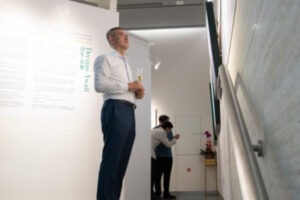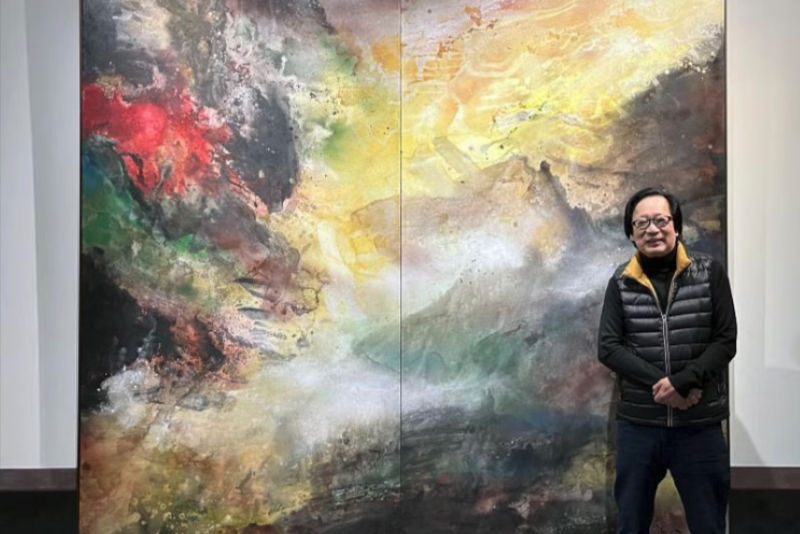Past
From Passion
to Mission
17 Aug – 29 Sep 2024
Tue – Sat: 11am to 7pm
Sun: 12pm – 5pm
Closed on Monday
Prestige Art Gallery
61 Stamford Rd #01-06 Singapore 178892
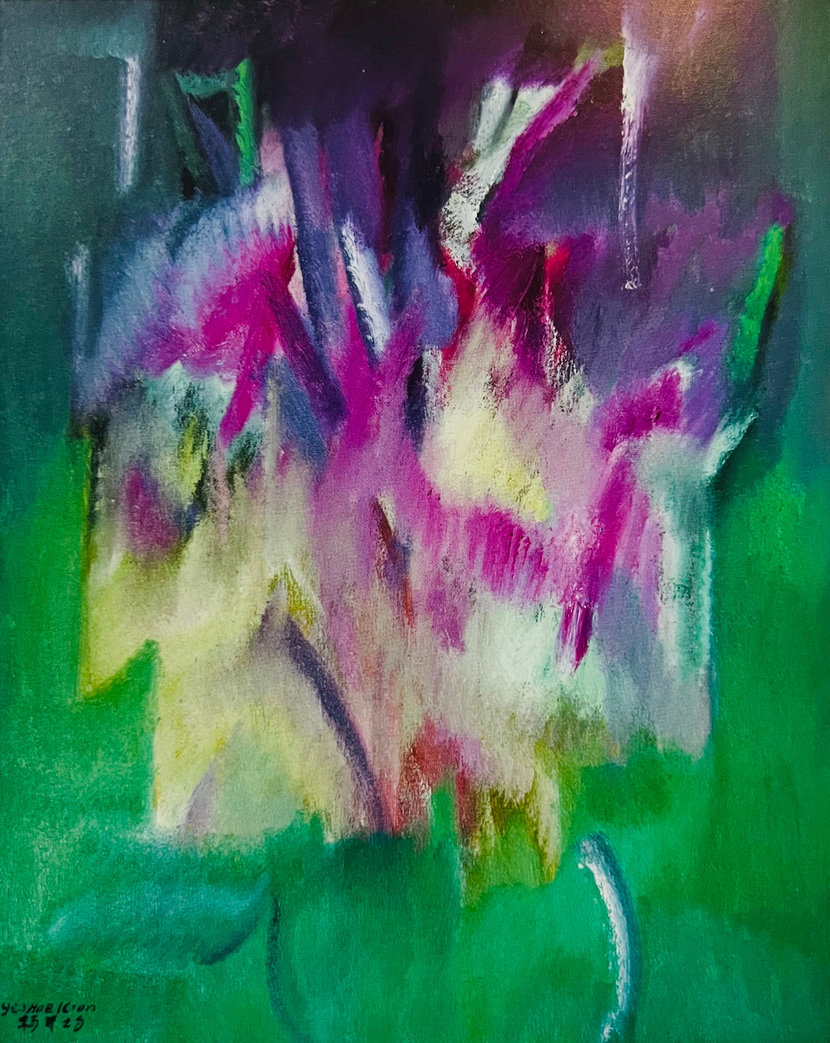
Purple Flowers, 2020, Oil Painting on Canvas, 100cm x 80cm, Yeo Hoe Koon
Exhibition Details:
From Passion to Mission
Group Exhibition of Southeast Asian Artists
17 Aug – 29 Sep 2024
Tue – Sat: 11am to 7pm
Sun: 12pm – 5pm
Closed on Monday
Artists:
Affandi (Indonesia)
Cheong Soo Pieng (Singapore)
Fadjar Sidik (Indonesia)
Ho Ho Ying (Singapore)
Lin Hsin Hsin (Singapore)
Lim Soo Ngee (Singapore)
Lee Man Fong (Indonesia/Singapore)
Justin Lee (Singapore)
Ng Yak Whee (Singapore)
Shui Tit Sing (Singapore)
Tan Choh Tee (Singapore)
Tang Da Wu (Singapore)
Teng Nee Cheong (Singapore)
Yeo Hoe Koon (Singapore/Malaysia)
Curators:
Audrey Zhang
Rick Shi
Academic Consultants:
Zhao Hong
Koh Nguang How
Assistant Curators:
Li Yan
Wu Shangying
Prestige Art Gallery
61 Stamford Rd
#01-06 Stamford Court
Singapore 178892
View map
Brochure:
From Passion to Mission
Prestige Art Gallery’s Inaugural Exhibition: From Passion to Mission – The Exploration and Contributions of Southeast Asian Artists
Celebrating Southeast Asian Artistry
In this inaugural exhibition, we present works by notable Southeast Asian artists, including Singapore’s vanguard artist Cheong Soo Pieng, Indonesia’s treasured artist Affandi, key figure of Indonesian abstract art Fadjar Sidik, alongside Ho Ho Ying, co-founder of the Modern Art Society Singapore, and Tang Da Wu, an iconic figure in the multimedia art scene of contemporary Asia.
Art with A Purpose
What began as a personal creative pursuit for these artists has evolved into a mission reflecting their compassion for society. Through perseverance in the face of challenges, these artists have significantly advanced the development of Southeast Asian art.
Inspiring Generations
These eminent artists not only achieved outstanding results in their artistic quests but have also inspired countless artists and viewers over the decades, influencing art in Asia and beyond.
A Transformative Era
Most of the displayed works date back to the 1980s, a unique period marked by economic reforms and the impact of foreign direct investment, which spurred growth and flourishment in the region. Singapore and Indonesia emerged as prominent stages showcasing creative advances, encouraging artists to engage in cross-cultural dialogue while navigating their identities.
Exploring Artistic Dimensions
Despite geographical and cultural differences, Abstractionism and Expressionism had a profound influence in Singapore and Indonesia during this historical period. Artists explored self-expression through freedom of form and bold colour palettes. The curators have chosen the guiding concepts of Lines and Colors to lead viewers into the depths of the presented art, encouraging dialogue with the artworks and inviting reflection on the zeitgeist and individual expression of each artist.
A Legacy of Innovation
Ho Ho Ying, a co-founding father of the Modern Art Society Singapore, advocated for the need for new modern art forms in a modern nation. Merging traditional Chinese art with Western Abstractionism, he developed a distinctive style now considered a revolutionary visual language. Inspired by Ho Ho Ying and his contemporaries, Tang Da Wu, alongside like-minded artists, established the Artists Village in 1988, introducing new art forms and addressing social issues through art. Southeast Asian artists have increasingly participated in cross-cultural dialogue through international exhibitions and collaborations, forging enriching connections with the world.
International Recognition
This exhibition also offers visitors the exciting opportunity to view two paintings by influential Indonesian artists Affandi and Fadjar Sidik, whose works were featured in the prestigious 60th Venice Biennale: Foreigners Everywhere. This presentation allowed an international audience to appreciate their enigmatic artistic styles and acknowledge Indonesia’s significant contributions to the contemporary art scene of the 20th century.
Nurturing the Artistic Ecosystem
By inaugurating our new gallery with this exhibition, we proudly showcase the works of exceptional artists whose creative explorations embody strong individuality while capturing the spirit of their times. These artists are not merely creators; they are also educators, critics, thinkers, and innovators. Passionate about their mission, drawing strength from a love for life, they use art as a vital medium to engage viewers in introspection about life and society. Inspired by their journeys, our Gallery aspires to contribute to the continuous development of the art scene by transforming our passion for art into a mission that supports artists and nurtures Singapore’s creative ecosystem.
Affandi (Indonesia)
Affandi (1907-1990) was an Indonesian artist. Born in Cirebon, he completed his high school education in Jakarta. He gave up his studies to pursue his desire to become an artist. Beginning in 1934, Affandi taught himself how to paint. He was married to fellow artist Maryati. In the 1950s, Affandi began creating expressionist paintings, and his distinctive style is known as “Squeeze Tube.” Affandi painted by squeezing the paint directly out of the tube, a technique he stumbled upon while trying to draw a line one day. When he lost patience searching for a missing pencil, he applied paint directly from the tube. The resulting effect, as he discovered, made the painted objects look more vivid. He also felt freer to express his feelings when using his hands instead of a paintbrush. Eventually, he became a celebrated oil painter in Indonesia.
Strongly resistant to idealistic portrayals of the Mooi Indies, Affandi is renowned for his commitment to honest expression. Rather than advocating a particular social ideology, he constantly challenged himself to depict the candid, everyday life of the Indonesian people. This dedication aligned with his co-founding of Sanggar Pelukis Rakyat (People’s Painter Studio) in 1947, which encouraged members to pursue their ideas of authenticity in art-making. With his unguarded style and bold subject matter, the Cirebon-born artist was one of Indonesia’s leading expressionist painters in the mid-20th century.
In the 1950s, Affandi began creating expressionist paintings. The piece Carrying the First Grandchild (1953) marked his newfound style known as “squeezing the tube.” Affandi painted by directly squeezing the paint out of its tube. He discovered this technique by accident when he intended to draw a line one day. Losing patience while searching for a missing pencil, he applied the paint directly from the tube. The resulting effect, as he found, made the painted object appear more alive. He also felt freer to express his feelings when he used his hands instead of a paintbrush. In certain respects, he acknowledged similarities with Vincent van Gogh.
A manifestation of energetic lines and loose brushwork, Affandi’s artistic manner is recognised for its expressive tension. With techniques such as applying paint directly from the tube, his spontaneous and curvilinear markings culminated in a fiercely dynamic sense of movement. The artist painted with immediacy and often completed an entire work in one sitting. Utilising a non-naturalistic colour palette, he illustrated a variety of Indonesian subjects, including fishing boats, dogs, markets, Balinese dancers, and more.

Balinese Boat, 1964, Oil on Canvas, 100cm x 140cm
Cheong Soo Pieng (Singapore)
The modern art movement in Singapore is inextricably linked with the term “Nanyang.” This art movement from the late 1940s does not refer to any specific subject matter or painting style; rather, it represents a perspective, a spiritual attitude, and an identity of the artists. It combines the styles and techniques of traditional Chinese painting with those of the Paris School. At the same time, “Nanyang” refers to the regions south of China, encompassing various Southeast Asian ethnic groups, including those in Java, Malaya, India, and the Chinese diaspora.
Art historians T.K. Sabapathy and Redza Piyadasa coined the term “Nanyang” during the 1979 retrospective exhibition of the first generation of Chinese immigrant artists in Singapore. These artists, who resided in Singapore, viewed the local culture and life from fresh perspectives, creating a new artistic vision under the influence of different cultures in the latter half of the twentieth century.
In 1952, Cheong Soo Pieng, Chen Wen Hsi, Liu Kang, and Chen Chong Swee set foot in Bali for the first time. This journey became a crucial cornerstone of the Nanyang art movement. They were warmly received by Belgian artist Adrien-Jean Le Mayeur. The group aimed to create a new artistic language that would represent the diverse cultural backgrounds of the Nanyang movement. During that time, Cheong Soo Pieng not only depicted the landscapes and customs of Bali but also began to boldly experiment with colour symbolism and non-representational art techniques. This trip was of great significance, marking the beginning of a creative journey that would last for forty years. The enchanting scenery of the island, akin to a tropical paradise, inspired their senses and established their artistic concepts, prompting them to continue exploring other parts of Southeast Asia.
In Cheong Soo Pieng’s work “Malay Life,” the depicted figures appear stationary, with time and space seemingly frozen. Although there is no visible movement, the scene is not lifeless. The figures exude an internal rhythm and stability, with each detail contributing to the overall harmonious composition. The artwork conveys a meditative tranquillity, as if guiding the viewer to the edge of paradise. Using lines to outline the expression of each person, the scene captures the grandeur of Malay life against the backdrop of a setting sun, reflecting the cultural heritage of the local people.
Through the idealised forms of the figures, Cheong Soo Pieng captures the essence of “Nanyang” and presents it to the world. “Malay Life” showcases Cheong Soo Pieng’s unique aesthetic vision and stands as an exemplary representation of his artistic career.

Malay Life, 1968, Oil on Canvas, 101.5cm x 81.5cm
Fadjar Sidik (Indonesia)
Fadjar Sidik was born in 1930 in Surabaya, Indonesia. He joined the social realist group Sanggar Pelukis Rakyat (The People’s Painters Studio) under the tutelage of Hendra Gunawan and Sudarso in 1947. He studied Literature at Gadjah Mada University in 1952 and Painting at the Indonesian Institute of the Arts in Yogyakarta in 1954. Distinct from his artistic peers’ pursuit of realist paintings, Fadjar Sidik was committed to the creative innovation of abstract forms and compositions, cementing his irreplaceable contribution to the development of modern abstract art in Indonesia. By using geometric imagery derived from natural elements, his compositions explore the universal relationship that exists between nature, space, and humanity, while reflecting the regional characteristics and spiritual consciousness of Indonesian culture.
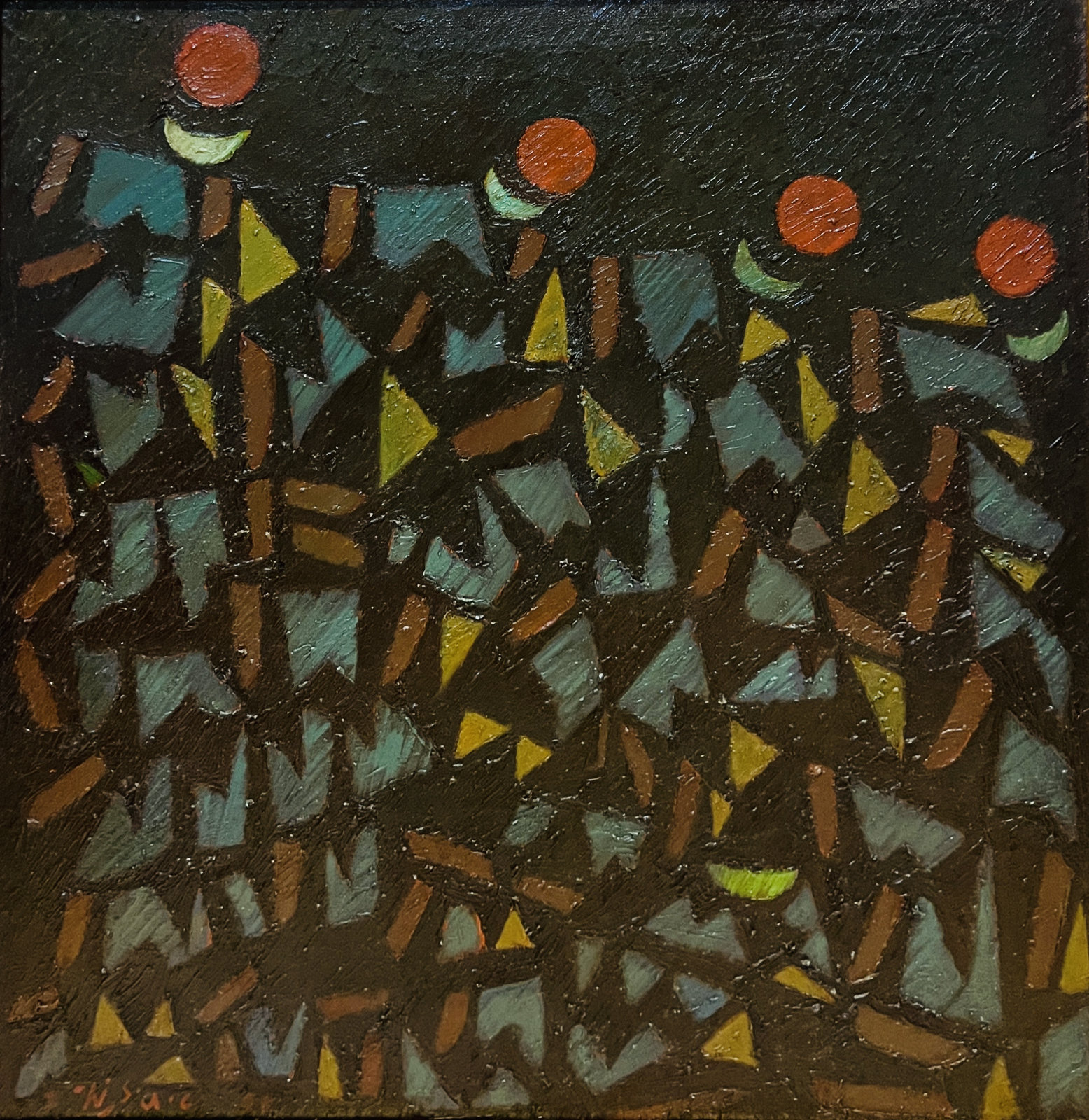
Space Dynamic, 1990, Oil on Canvas, 75cm x 75cm
Ho Ho Ying (Singapore)
Ho Ho Ying (Chinese: 何和应), also known by his writer’s moniker, Zi Mu (Chinese: 子木), was a prominent Singaporean modern artist whose practice involved avant-garde Chinese calligraphy and abstract expressionist paintings. He co-founded the Modern Art Society in Singapore during the 1960s and was an art critic who wrote essays advocating for Singapore’s art to grow in a new direction, arguing the case for abstraction over realism.
We analyse Ho Ho Ying’s 1970s work Flame through inorganic lines. In the 1960s, he was influenced by world masters such as Kandinsky, Jackson Pollock, Matisse, and Picasso, with Jackson Pollock’s abstract expressionism having a particularly profound impact on him. Through his innovative works of the 1970s, he abandoned realism.
In the 1970s, Ho Ho Ying proposed that art must possess new creativity, new concepts, and new inspiration for it to continue developing. Gradually, his painting style formed a mature system known as “splashed colour with inorganic lines.” He used different ratios of colours to achieve a perfect blend of oil and pigments, creating larger colour blocks and enhancing the depth of field between the colour blocks and the background. By guiding the flow of paint onto the canvas with a stick from a container of carefully adjusted colours, he formed continuous ‘lines’ of colour on the canvas.
This extreme splashing technique produced tree-like flowing lines, where the interweaving of these flowing lines revealed the artist’s wild energy on the canvas, resembling a ship braving stormy seas. The characteristics of these lines are determined by the movements of the artist’s body, particularly the variations in his upper limbs and painting materials: the viscosity of the paint (controlled by reducing thickness and diluting it); the angle of pouring and the resulting pouring speed influence the effect on the canvas. This process also originates from Ho Ho Ying’s bodily movements, especially the strength expressed through his wrist, arm, and shoulder. At times, he could move swiftly and at other times with rhythmic precision. By boldly breaking away from traditional painting techniques, the effects achieved are inevitably random.
Such pioneering works influenced artists in Southeast Asia and surrounding regions. Ho Ho Ying’s painting Ode to the West Wind also pays homage to the artist Affandi, who was known for his “line” paintings. Ho Ho Ying was influenced by Affandi’s work, which inspired his own style of intertwining lines and colours. Art is interconnected, bridging the artistic languages of Southeast Asia and the West, reflecting how Southeast Asian art in the post-1980s era was quite avant-garde.

Ode to West Wind, 1977, Oil on Canvas, 85.5cm x 85cm
Lin Hsin Hsin (Singapore)
Lin Hsin Hsin is an award-winning interdisciplinary artist, IT visionary, and inventor who has worked across various media and pioneered early digital techniques in visual and performing arts. Deeply rooted in mathematics and computer science, she is also a poet and composer. In 1994, she launched the world’s first virtual museum and decisively abandoned traditional painting methods to create new technological paradigms. While studying in Singapore, Lin was greatly influenced by the art philosophies of Liu Kang and Cheong Soo Pieng. Later, she learned printmaking from David Narker and Steven Lawlor at the University of Ulster. In 1991, she studied papermaking with Mr. H. Kubo in Ogawamachi, Japan. She continuously updates her knowledge by frequently visiting museums, art galleries, and contemporary art fairs around the world.
Lin’s artworks span from the 1960s to the 1990s, featuring arrangements in colour and musical rhythm that align with her abstract art characteristics. One area of the exhibition focuses on her recent digital art, while the front hall displays her poetry and music compositions. Overall, these works showcase the breadth and endurance of Lin’s creativity and her unique contribution to Singapore’s post-Independence art scene.
In her artistic innovations, Lin Hsin Hsin was profoundly influenced by her teacher, Cheong Soo Pieng, which led to her boundless contemplation of the future of the world. She experimented with the transition from line to line, from line to surface, and from surface to surface, exploring whether art and science might converge at a common endpoint. This ongoing series evolved from her exchanges with Cheong Soo Pieng.

Path to the Future, 1976, Oil on Canvas, 82cm x 102cm
Lim Soo Ngee (Singapore)
Lim Soo Ngee is a renowned Singaporean sculptor celebrated for his exquisite works in wood and stone. Born in 1962, he studied at the Nanyang Academy of Fine Arts (NAFA), earning a Diploma in Fine Art (Sculpture) in 1989. He later pursued a Master of Fine Arts (Sculpture) from the Edinburgh College of Art in 1997. Lim has represented Singapore in numerous local and international exhibitions and is a regular contributor to international sculpture symposiums, including the inaugural International Woodcarving Symposium in Singapore in 2007 and the Hong Kong International Sculpture Symposium in 2009. His works are part of the permanent collections at esteemed institutions such as the Singapore National Gallery and the Asian Sculpture Theme Park in Inner Mongolia, China.
Lim’s artistic approach is deeply rooted in exploring the relationships between humanity, the environment, and society. His works often present whimsical narratives that comment on the human condition. At the heart of his artistic endeavours lies an ambitious dream: to carve and bring to life 100 distinct characters, each meticulously sculpted from the raw, organic medium of wooden logs. This pursuit showcases his remarkable technical prowess and deep appreciation for the inherent beauty of natural materials.
“I enjoy the process of creating the most—the sublimation of the active mind and the serenity of the senses,” says Lim. His artistic journey has evolved from abstract explorations to more representational works that reflect his personal experiences and cultural heritage. Lim’s art exemplifies how a piece can subtly convey the artist’s cultural identity without overt effort, enchanting viewers with its ease and playfulness.
Lim Soo Ngee possesses a unique talent for discovering the intriguing flaws in life, presenting his perspective in a casual and relaxed manner. Through his wood carvings, he seeks to transcend the mundane, transforming the ordinary into the extraordinary. By imbuing each character with a distinct personality and narrative, he invites his audience to engage with the work on a deeper emotional level, fostering a profound connection between the viewer and the art.
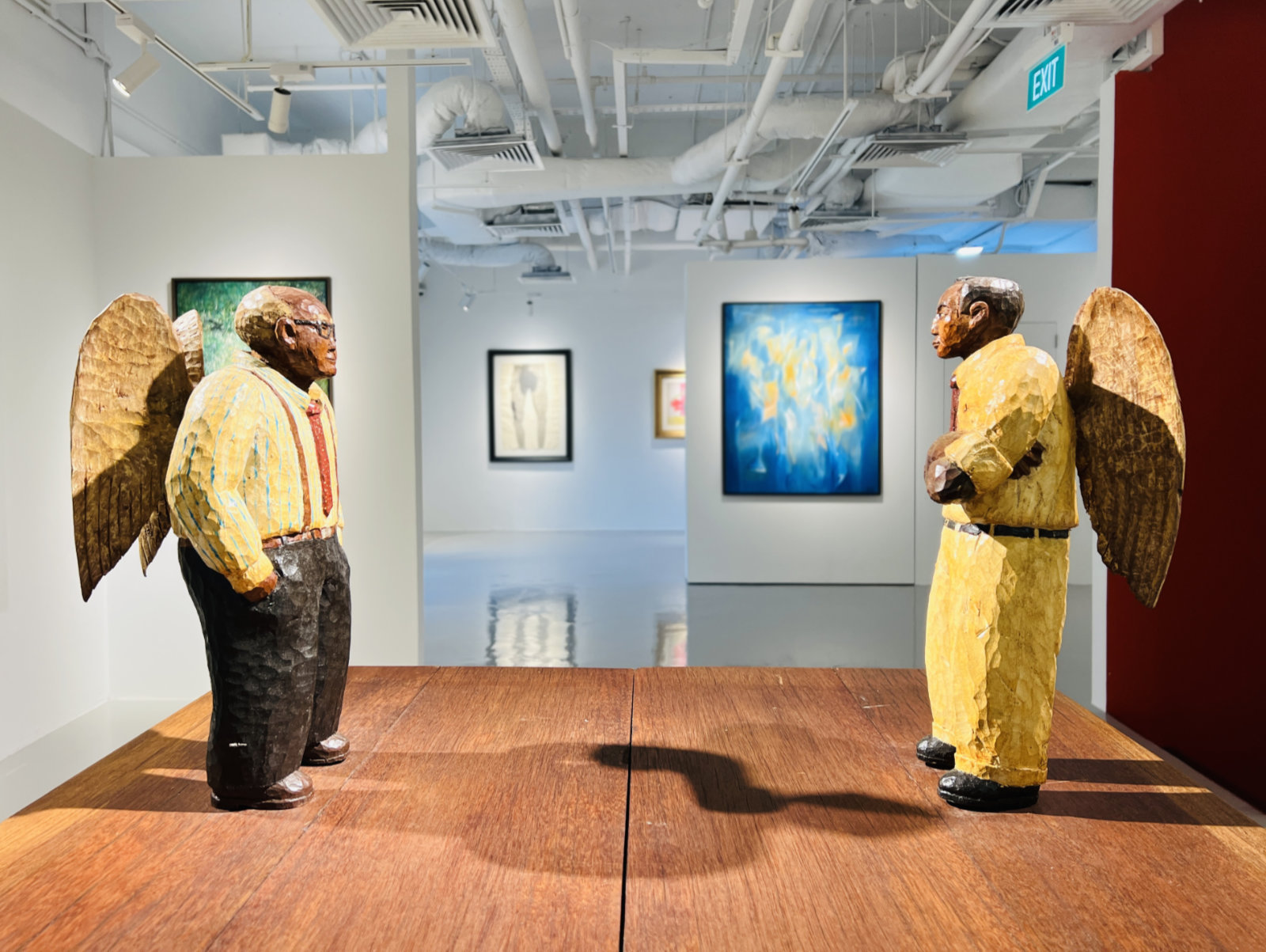
“Hey! Brother” “Hey! Mr Lin”, 2010, Painted Wood Sculpture, 147cm x 76cm x 94cm
Lee Man Fong (Indonesia/Singapore)
Lee Man Fong (b. 1913, Guangdong, China – d. 1988, Jakarta, Indonesia) was a prominent artist based in Indonesia and Singapore. Primarily working with oil paintings, Lee was associated with the Nanyang style, which blends Chinese techniques and subjects with Western compositional styles and mediums.
Regarded as a master of Southeast Asian art, Lee Man Fong skillfully combined traditional Chinese art with modern European elements. He excelled in oil painting on hardboard (utilising a unique framing technique) and canvas, while also conducting in-depth explorations of various media, such as pencil and watercolour. His works feature a wide variety of themes, often drawing inspiration from everyday life. He was particularly adept at depicting subjects such as peace doves, scenes of Balinese life, and goldfish. The oil layers in the backgrounds of his paintings are exceptionally thin, showcasing the artist’s perfect control over depth of field. He alternated mid-level details with fine lines and employed heavy brushstrokes to outline the main subjects, while the remaining colours accentuated the highlights of the central theme. The texture of the oil blended with the pigments creates a harmonious connection between the foreground, middle ground, and background.
Lee Man Fong’s hardboard oil paintings are especially unique due to their distinctive framing style. These vertical-format works are encased in finely polished solid wood, with an additional layer of leather between the painting and the outer frame, resulting in truly exceptional pieces. Lee Man Fong is highly sought after in both secondary and auction markets, reflecting the significant collectible value of his works.
Source of Information for This Work in the Publication:
Mikke Susanto, Sukarno’s Favourite Painters, Published by PT. Dwi Samapersada, Jakarta, 2018, Page. 217
Siont Teja, Lee Man Fong: Oil Paintings, Volume I, Published by Art Retreat, a Private art museum, Singapore, 2005, Page. 294
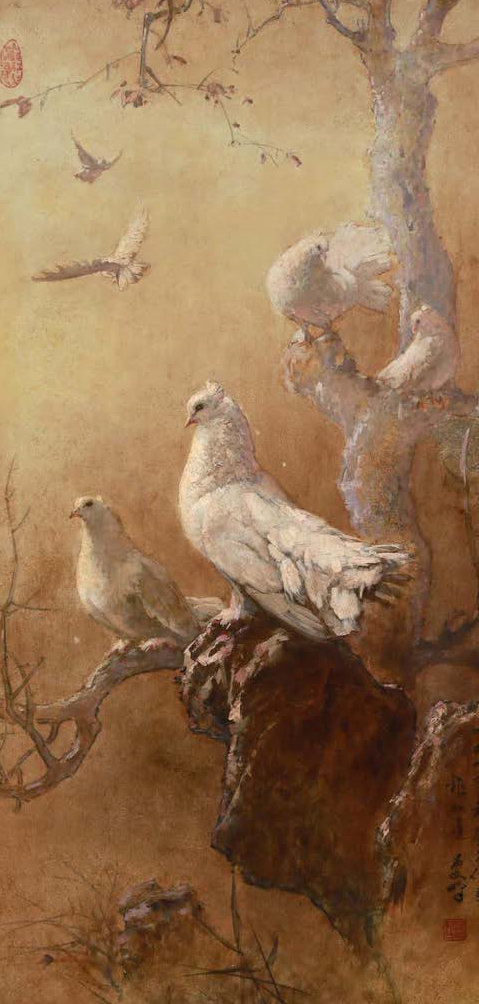
Peace, 1980, Oil on Wood Panel, 104cm x 51cm
Justin Lee (Singapore)
Justin Lee is a Singaporean visual artist and designer. He has participated in numerous artist-in-residence programmes in Japan, including Fukuoka, Studio Kura, Itoshima Art Farm, and Tokyo Youkobo. After graduating with a Diploma in Fine Arts, he was one of the selected local artists trained at the Tyler Print Institute in New York. Over the years, he has participated in numerous exhibitions held in Singapore and internationally (2000–2002). As one of Singapore’s foremost pop artists, whose design projects reflect a refined sense of contemporary design infused with the essence of Singaporean traditions, Justin’s work deserves accolades as both a designer and an artist. His approach to design is executed with modern graphic fundamentals yet reflects traditional techniques, such as his ongoing series based on paper cutting and Chinese woodblock printing styles. The themes and imagery through which he interprets his commissioned design work underscore familiar Asian cultures with a delightful pop treatment that celebrates Asian values in an endearing, tongue-in-cheek manner.

Happy Warrior, 2015, Fibreglass, 76cm x 60cm x 23cm
Ng Yak Whee (Singapore)
Ng Yak Whee, born in Singapore and holding an honours bachelor’s degree in biology from Nanyang University, Singapore (1979), has had a lifelong passion for creativity. After completing his academic journey, he followed his inner calling and embarked on a career as a professional artist. Ng Yak Whee’s artistic style is notably influenced by the Russian-French artist Marc Chagall, offering a departure from traditional art movements such as Impressionism, Cubism, and Abstract Expressionism. He demonstrates versatility across various mediums, including oil, acrylic, ink painting, cartogravures, and photography. His artwork breaks away from conventional single-perspective depictions, embracing multiple viewpoints within a single image. This approach yields dream-like imagery imbued with his distinctive style and a keen sense of colour.
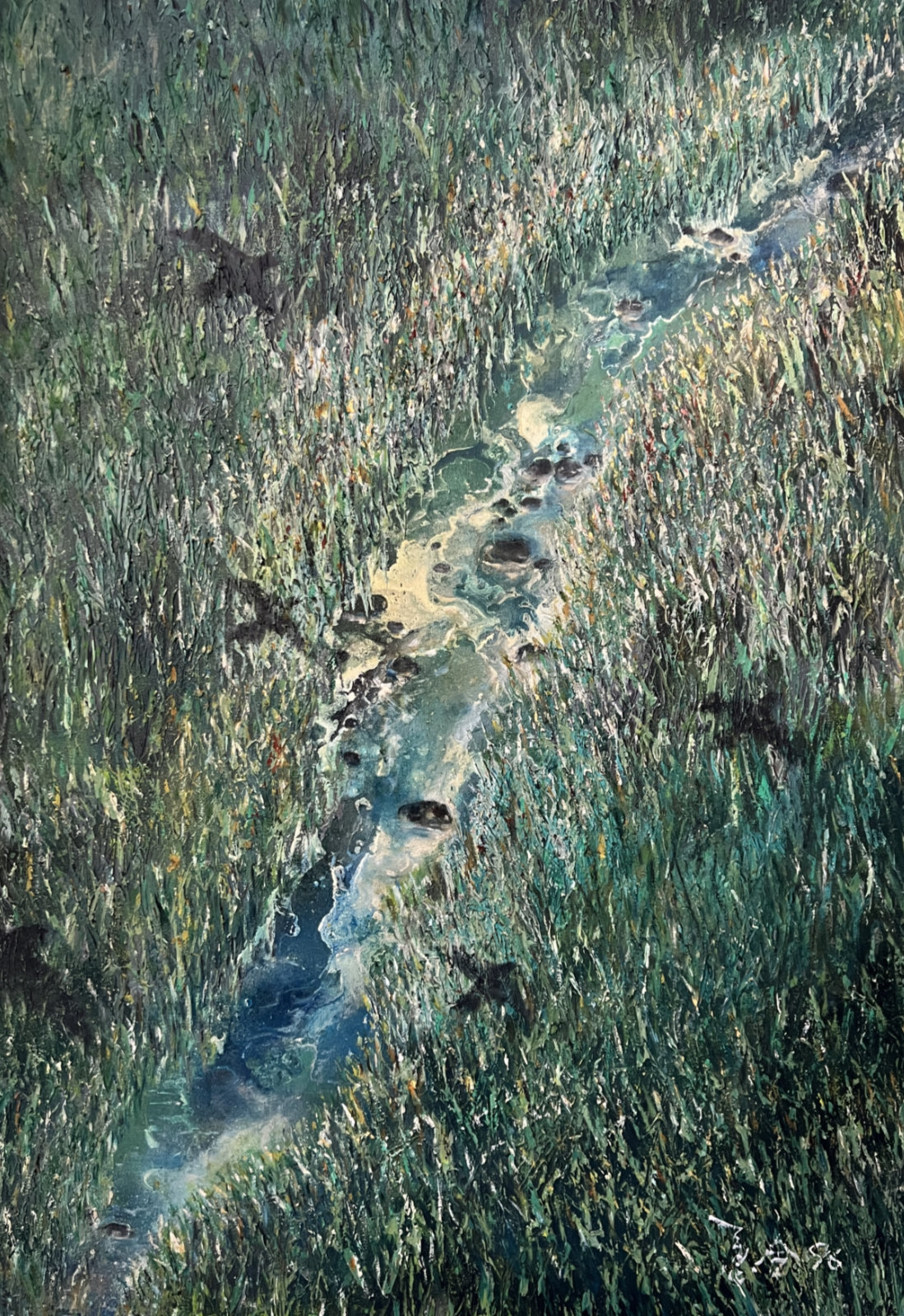
Freedom, 1996, Oil on Canvas, 100cm x 70cm
Shui Tit Sing (Singapore)
Shui Tit Sing (1914-1997) was born in Kaiping County, Guangdong Province, China, in 1914. He studied at the Hangzhou National College of Art (Painting Department), graduating in 1937, and also attended the National College of Art (Western Painting Department), from which he graduated in 1940. Following his graduation, he moved to Singapore, where he taught art and Chinese language at Catholic High School from 1948 to 1977. He was a regular exhibitor at major group exhibitions in Singapore and an active member of the Society of Chinese Artists. Additionally, he was involved in artistic tours with the Ten Men Art Group to various locations in Southeast Asia during the 1960s and 1970s. From 1968 onwards, Shui focused entirely on wood carving. He believed that his teak sculptures were oriental in style and aimed to impart a sense of reality, reflecting the hardworking lives of ordinary people engaged in their daily activities. Created with a pure intent to represent the living world, Shui’s oeuvre becomes a point where art and life converge.
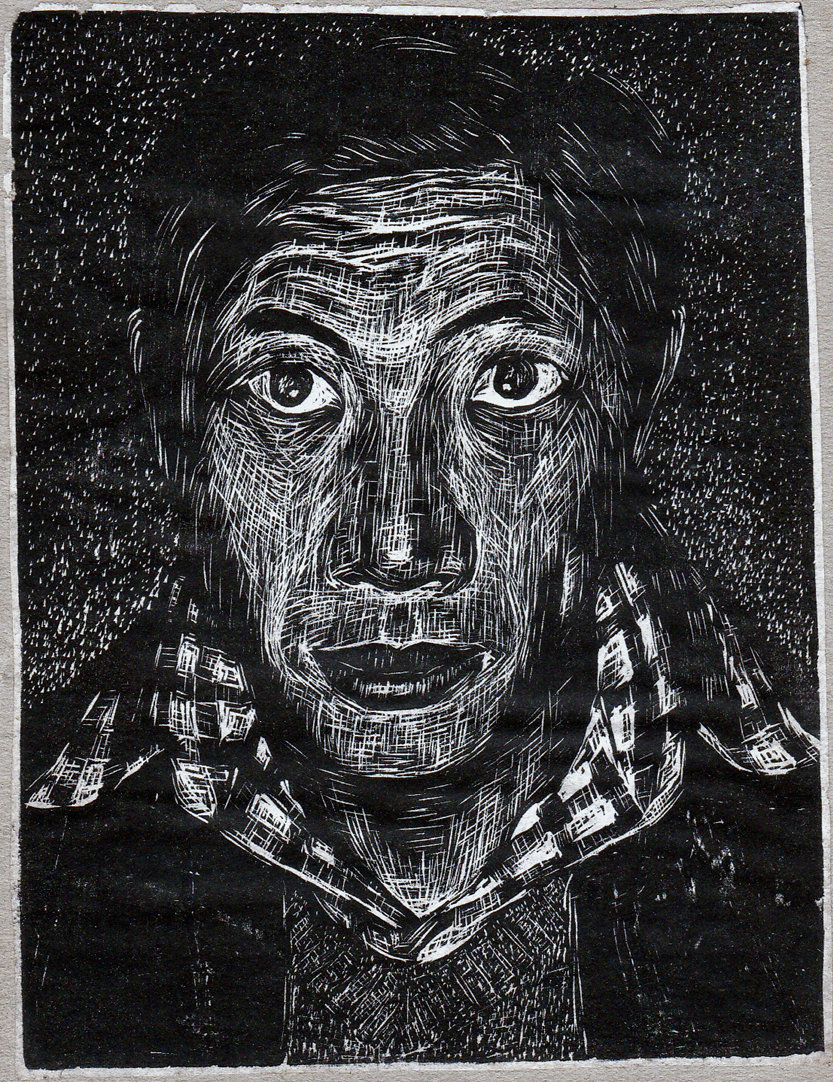
Self Portrait, 1937-1940, Woodblock Print, 11.9cm x 9cm
Tan Choh Tee (Singapore)
Tan Choh Tee, born in 1942, received the Cultural Medallion for Visual Arts from the Singapore Government in 2006. He studied at the Nanyang Academy of Fine Arts under the guidance of pioneer artists such as Cheong Soo Pieng, Liu Kang, and Georgette Chen. Renowned for his oil paintings in still life and landscapes, Master Tan was initially influenced by Impressionism. Later, his still life works were shaped by the Italian modernist still life master, Giorgio Morandi. His paintings feature intense colours—starkly contrasting with Morandi’s palette—and dynamic brushwork, evoking deep emotional responses from viewers.
When analysing Tan Choh Tee’s Still Life – Flowers, we observe that he focuses exclusively on still life and landscape painting. He is highly sensitive to tone, colour, and compositional balance, often depicting Southeast Asian modernist still lifes using broad strokes of colour with a palette knife. His work explores endless possibilities within constancy, and he enjoys travelling to different countries to experience local customs and create records.
Tan Choh Tee’s art reflects the influence of Giorgio Morandi, particularly in his sophisticated use of greys, similar to Morandi’s high-quality greys for contrast. He employs large colour blocks to convey variations in light on still lifes, using a light-toned vase against a dark background to create depth. This technique highlights the effect of the flowers in the vase and showcases the texture of large colour blocks in the flowers. The contrasting colours emphasise the artist’s delicate expression of life’s details, resulting in a unique painting language.
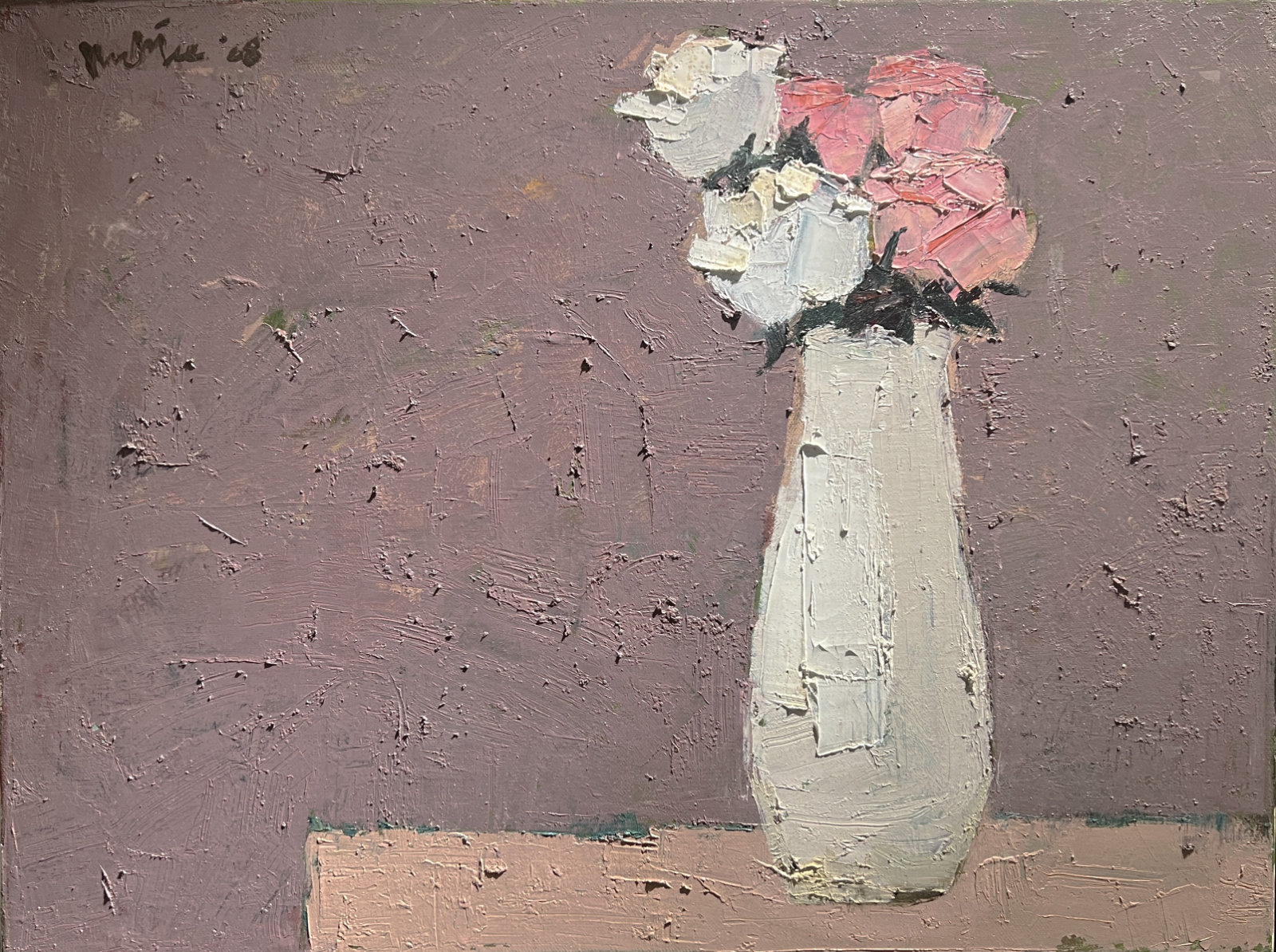
Still Life – Flowers, 2011, Oil on Canvas, 71cm x 46cm
Tang Da Wu (Singapore)
Tang Da Wu is the founder of Singapore’s seminal The Artists Village and is a prominent Southeast Asian performance artist; he is among the most distinguished figures in contemporary art in Singapore. Contemplating his own identity as a Chinese Singaporean, Tang uses a broad array of media with local references and iconography to engage in his performance art. His works have been performed and exhibited in countries such as England, Japan, Germany, Australia, the Philippines, Malaysia, and Indonesia, earning him recognition as one of the most representative contemporary artists in Southeast Asia today.
For Bumiputra (2005–06) (the title is Malay for ‘son of the soil’ or original inhabitant), he created portraits in Chinese ink of residents from the northern Singapore suburb of Hougang, which was transformed from a pig-farming village into a ‘new town’ of high-rise apartments and shopping malls in the 1980s. In addition to continuing the artist’s interest in the relationship between people and the environment, the paintings convey his emphasis on spontaneity and improvisation. By dampening the paper before applying the ink, Tang employs bleeding and staining to evocative effect, creating suggestive portrayals that attempt to capture the essence or spirit of his subjects. Far from condos and credit cards, their emblems include a hoe, a community well, banana leaves, and buckets. In Tang’s work, it is the people who give meaning to the label “People of the Land,” not the other way around.

Bumiputra Series – Under the Banana Leaf, 2005, Chinese Ink and Colour on Watercolour Paper, 103cm x 69cm
Teng Nee Cheong (Singapore)
Teng Nee Cheong (b. 1951, Singapore; d. 2013, Singapore) was renowned for his richly coloured oil paintings and charcoal drawings of the human figure. His earlier works consisted of a series of decorative semi-abstract paintings depicting frangipani treetops. Teng’s art reflects his fascination with Asian cultures, religions, and traditions, drawing inspiration from Balinese mythology, Hinduism, Buddhism, Asian mural paintings, and Persian miniatures. He was also influenced by the gilded Art Nouveau paintings of Austrian symbolist artist Gustav Klimt. Teng’s works are included in the collections of Singtel, the Singapore Art Museum, the Ministry of Foreign Affairs, and the Neka Museum in Bali, Indonesia.
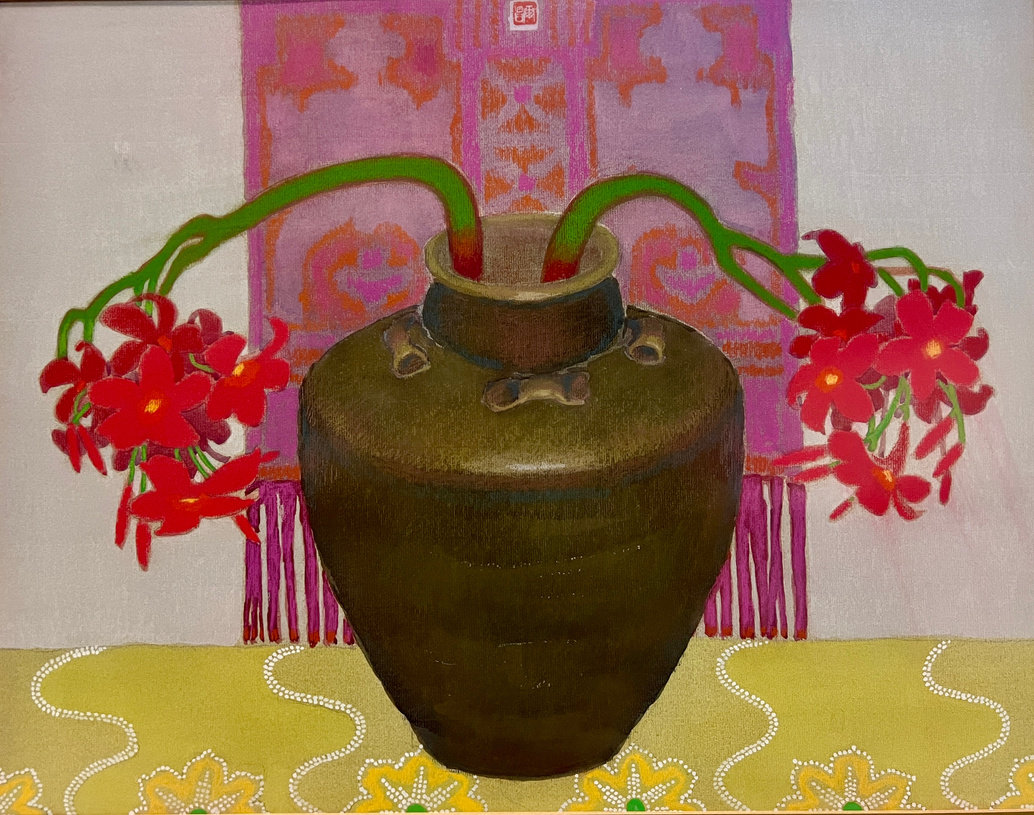
The Double Blossom, 1989, Oil Pastel on Paper, 64cm x 49cm
Yeo Hoe Koon (Singapore/Malaysia)
Yeo Hoe Koon, a Singaporean painter and alumnus of the Nanyang Academy of Fine Arts (NAFA), trained at NAFA from 1955 to 1957. Encouraged by his teacher Georgette Chen, he attended the École Nationale Supérieure des Beaux-Arts in Paris in 1959. The Western art movements in Europe during the 1950s and 60s had a profound impact on him, leading him to express his roots as a Chinese artist through a vocabulary of abstraction that integrates the spirit of traditional Chinese culture with the freshness of Western forms. Yeo has been a painter for over six decades and is skilled in oil, acrylic, and Chinese ink painting. Now well into his 80s, Yeo remains full of vitality and energy, creating art and believing in its power to transform and touch people. For him, art represents light and hope.

Bouquet, 2021, Oil on Canvas 150cm x 120cm


